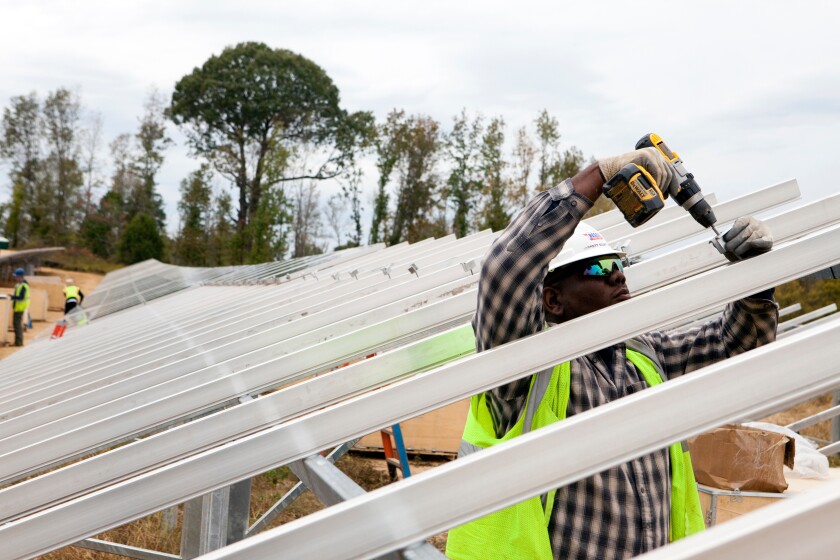Scientists and other experts have dated the effects of climate change to the Industrial Revolution of the 1830s, when warming from greenhouse gases was first detected in the Arctic and tropical oceans. Since that time, the effects of climate change have only increased, in lockstep with natural disasters and rising global temperatures.
For example, the National Oceanic and Atmospheric Administration hasclocked in 323 weather and climate disasters since 1980 that resulted in damages and costs reaching or exceeding $1 billion. The total cost of these events exceeds $2.195 trillion.
So, How Does Clean Energy Come Into Play?
Currently, clean energy options include solar, wind, water, geothermal, bioenergy, hydrogen and fuel cell technologies. Using these energy sources, experts argue, would lower the amount of harmful greenhouse gasses affecting the atmosphere when compared to traditional options like petroleum, natural gas and coal.
At the moment, current energy production is responsible for 87 percent of global greenhouse gas emissions, according to an article byOur World in Data. If that percentage were to go down, many of the climate-related issues we see today would lessen significantly. However, the tricky part of using clean energy options tends to be their inconsistencies.
“There’s a particular issue with some of the technologies like wind and solar,” Warren Leon, executive director of the Clean Energy States Alliance, said. “The sun doesn’t shine 24 hours a day, and the wind doesn’t blow 24 hours a day.”
Other challenges — especially for states — are reaching 100 percent clean energy and maintaining it. Leon told Government Technology*, “States aren’t at the point of being at 100 percent. I would say almost every state in the country is making some degree of progress, but when you get to very high concentrations of renewable energy, it becomes harder.”
Despite the challenges, he added, a handful of states have been motivated to incorporate clean energy — aside from the obvious environmental benefits — because of the economic development and employment opportunities.
What Have States Done So Far?
According to the Clean Energy States Alliance’swebsite, 21 states, as well as Puerto Rico and Washington, D.C., have enacted clean energy legislation or executive orders. For example, California, Colorado, Connecticut, Nevada, New Jersey, New Mexico, New York, Virginia and Wisconsin aim to be carbon-free between 2040 and 2050.
Puerto Rico; Washington, D.C.; Rhode Island; and Hawaii have proposed using renewable energy between 2030 and 2050. Meanwhile, Louisiana, Maryland, Massachusetts and Oregon intend to have net-zero greenhouse gas emissions between 2040 and 2050.
In Wisconsin, Gov. Tony Evers recently announced the state’s first clean energy plan, detailing different objectives to achieve 100 percent carbon-free electricity by 2050.
“Every Wisconsinite has experienced the effects of climate change, whether they live in the Driftless, the Central Sands, the Northwoods or in the heart of our urban areas,” Evers said in an email. “Our strong tradition of conservation means we don’t have to choose between mitigating climate change and protecting our environment and good-paying jobs and economic development — we can do both.”
Within the state’s clean energy plan are strategies to accomplish these goals, including lowering energy bills, prioritizing environmental justice and ensuring that healthy communities have a more affordable, accessible and sustainable future, Evers added.
As for enacting the plan, Maria Redmond, director of the Wisconsin Office of Sustainability and Clean Energy said, it has been a long time coming and a much-needed effort.
“For a long period of time, about eight years or so, our state did not address climate change; we kind of worked on energy in the background and let things chug along,” Redmond said.
The problem with this, she explained, is Wisconsin has little to no fossil fuel production, resulting in the state paying other states for resources like natural gas, petroleum and coal to generate electricity.
A 2019 study conducted by the Center on Wisconsin Strategy found that the state pays $14 billion for external energy resources, prompting agencies, utilities and lawmakers to hunt for a cheaper solution.
“We've been talking with state agencies along the way and other associated groups, and they are ready to go,” Redmond said. “We're going to be meeting with a lot of people and organizations over the next couple of months to start the process of implementing the plan. We don’t want to waste any time.”
As for other states, New York, Colorado and Maine are requiring regulators to implement new rules to guarantee economywide cuts in greenhouse gas pollution and support frontline communities and workers during the energy transition process.
Virginia also looks to do something similar by cutting down greenhouse gas pollution in the power sector, creating goals for energy storage and offshore wind energy deployment, and codifying a 2019 executive order for 100 percent clean electricity, according to the Virginia Clean Economy Act.
For states' plans to work, Leon said, they need to have a good plan in place and must identify and address the barriers with careful planning and aggressive implementation.
"I would say more states are doing these things, but there's a lot more work that needs to be done,” Leon said.
Federal Support for States Clean Energy Plans
As for other efforts to help states reach their clean energy goals, the Department of Energy’s (DOE) Weatherization and Intergovernmental Programs Office emphasized the importance of increased funding from the bipartisan infrastructure law (BIL) and annual congressional appropriations.
"BIL invests billions of dollars into new and existing programs, which will help amplify and expand the impacts of its programs and help drive states’ clean energy investments," a spokesperson for the office said via email.
Some of these investments include $3.5 billion for the Weatherization Assistance Program, for which applications have already been released; $550 million for the Energy Efficiency and Conservation Block Grant Program; $500 million for the State Energy Program; $250 million for the new Energy Efficiency Revolving Loan Fund Capitalization Grant Program; and $40 million for the Energy Auditor Training Grant Program.
"This is just a small slice of the more than $62 billion appropriated to DOE by BIL that will be invested in supporting an equitable clean energy future," the spokesperson added.
*Government Technology is a sister site to Governing. Both are divisions of e.Republic.











